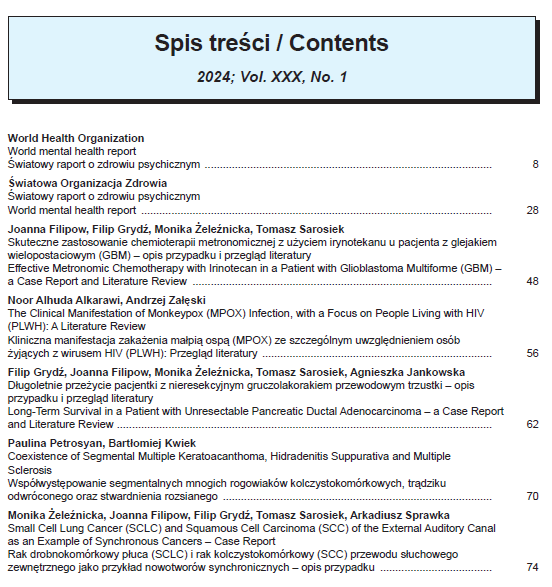Szanowni Państwo, drodzy Czytelnicy,
oddaję w Państwa ręce pierwszy w tym roku numer XXX tomu kwartalnika „Review of Medical Practice”.
W aktualnym wydaniu prezentujemy Państwu wiele interesujących publikacji, a wśród nich m.in. opracowanie pod tytułem Długoletnie przeżycie pacjentki z nieresekcyjnym gruczolakorakiem przewodowym trzustki – opis przypadku i przegląd literatury.
Nowotwory trzustki bardzo często cechują się szybką dynamiką wzrostu, trudnym leczeniem pacjentów oraz krótkim czasem przeżycia od rozpoznania. Jedyną możliwością leczenia jest radykalny zabieg chirurgiczny. Odsetek pięcioletnich przeżyć po resekcji nie przekracza 20%, a w przypadku guzów nieresekcyjnych bez przerzutów odległych jedynie ok. 5%. Częstość występowania raka trzustki wzrasta wraz z wiekiem – ponad 80% raków trzustki występuje po 55 r.ż., a najczęściej występuje w 7.–8. dekadzie życia.
W pracy przedstawiono przypadek 51-letniej pacjentki z rozpoznanym przed 13 laty nieoperacyjnym gruczolakiem raka trzustki. Przypadek ten zwraca uwagę na konieczność poszukiwania genetycznych przyczyn choroby oraz zastosowania zindywidualizowanej terapii i stosowania medycyny spersonalizowanej.
Interesująca jest również praca Rak drobnokomórkowy płuca (SCLC) i rak kolczystokomórkowy (SCC) przewodu słuchowego zewnętrznego jako przykład nowotworów synchronicznych – opis przypadku. U 66-letniej (obecnie 74-letniej) pacjentki diagnozowanej z powodu pogorszenia słuchu rozpoznano nowotwór przewodu słuchowego zewnętrznego.
W trakcie diagnostyki wykonano m.in. badania PET-CT celem wykluczenia ognisk przerzutowych. Uwidoczniono aktywną metabolicznie zmianę we wnęce płuca lewego oraz nadnerczu prawym. W trakcie dalszej diagnostyki rozpoznano zmianę jako niezależne ognisko nowotworowe pierwotnie zlokalizowane w płucu o morfologii raka drobnokomórkowego w stadium IV z przerzutem do nadnercza prawego. Celem artykułu jest podkreślenie znaczenia wnikliwej diagnostyki zmian pierwotnych i wtórnych u pacjentów onkologicznych.
Na uwagę zasługuje także praca Skuteczne zastosowanie chemioterapii metronomicznej z użyciem irynotekanu u pacjenta z glejakiem wielopostaciowym (GBM) – opis przypadku i przegląd literatury. Opis przedstawia 46-letniego pacjenta z rozpoznaniem sprzed sześciu laty glejakiem wielopostaciowym. Proces terapeutyczny obejmował nieskuteczną radioterapię, chemioterapię temozolomidem oraz schemat PCV. Dopiero po zastosowaniu niestandardowej terapii metronomicznej (MCT) irynotekanem uzyskano stabilizację choroby w oparciu o skalę RECIST. Pacjent od rozpoczęcia leczenia pozostaje niezmiennie w dobrym stanie ogólnym. Mediana całkowitego czasu przeżycia od momentu rozpoznania u leczonych pacjentów z glejakiem wielopostaciowym wynosi około 8 miesięcy. Natomiast czas jaki upłynął od rozpoznania GBM u opisanego chorego wynosi już 6 lat i zdecydowanie odbiega od średniej w tej grupie chorych. Wskazuje to na istotność zastosowania terapii niestandardowych, w przypadkach gdy standardowe terapie nie dały pożądanych efektów w postaci stabilizacji lub regresji choroby oraz gdy brak jest przeciwwskazań. Niestandardowa terapia metronomiczna jest stosunkowo nową i mało powszechną metodą leczenia, ale także wykazuje minimalną toksyczność. Należy więc ją uwzględnić u chorych z rozpoznaniem GBM.
Z poważaniem
Redaktor Naczelna
dr hab. n. med. Anna Wilmowska-Pietruszyńska, prof. UŁa
